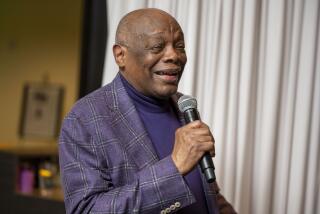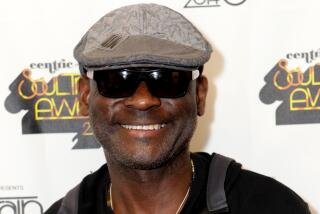Brown Is Taking On Gang Tacklers
No one ran nicer with the football than Jim Brown. No one. Not Franco Harris, Bronko Nagurski, Earl Campbell. Brown was the last of the unstoppables.
You had to be there. He could run around you, over you or through you. It was your choice. It just depended on whether you wanted a nosebleed or a stiff neck or to ache all over.
He was big (240) but not massive, fast (4.45 in the 40) but not Olympian, elusive but not apt to disappear altogether like a Gale Sayers.
He wasn’t a player, he was a team. Some people thought the team, the Browns, were named after him. They weren’t. But they should have been.
In his college days, he put Syracuse in the Cotton Bowl. He would have put the Browns in a Super Bowl, except in his day, there wasn’t any. He stopped playing the year before it came into being. But he led Cleveland to what was then the title game the two previous years.
When Brown retired, it was widely reported 10 league linebackers canceled their insurance. Others thought of coming out of retirement.
You could look it up, as Casey Stengel used to say. He scored a total of 756 points. In nine years. Usually only field-goal kickers run up those kinds of totals.
He had 126 touchdowns. Sometimes he scored five a game. He scored touchdowns in 10 consecutive games once. He rushed for 12,312 yards, averaged more than five yards per carry. Once he got into the secondary, you needed a lasso. He had 80-yard touchdown runs twice in his career. He could score from your one or his one. Just give him the ball and get out of his way.
Jim Brown is still going for the end zone. He doesn’t have a football any more, he has a cell phone and E-mail and another tough line to crack. As usual, he’s doing it.
The opponent this time is not the Detroit Lions, or the Sam Huff Giants, it’s the gang culture, the cult of violence in our society. It has a stacked defense. They play by no rules in this game, no offsides, no holding calls, no zebras with whistles to keep them in line.
What’s facing America today, Brown says, is a Super Bowl for survival. The enemy is within. It’s us.
Great societies have always been destroyed from within, from Greece and Rome to the Mayans. It used to be barbarians. Today, Brown says, the threats are gang violence, rising instances of heinous crimes, teenage pregnancy, joblessness, hopelessness. It’s not an inner-city problem, it’s a national problem.
Brown formed the “Amer-I-Can” foundation (with $350,000 of his own money) with a view to attacking the problem at the source. It is a program that tries for first downs, so to speak, not Hail Mary passes. You beat this opponent 10 yards at a time, not by miracle strikes.
“Our target is despair,” Brown explains. “We have to show there’s another way. We have to replace ‘I can’t’ with ‘I can.’ That’s what ‘Amer-I-Can’ stands for. We’re not the Boy Scouts. We’re not the 4-H Club. We have our own reality to deal with.”
He deals with it by sending “facilitators” not only into the neighborhoods but into the prisons. The goal, as he explains it, is to show the youth, the gang-bangers, there is another way. “In 1992, we were able to help to bring about the peace treaty in Watts. The homicide rate went down dramatically. What we want is for it to go down to zero. We’re not playing for a tie.”
He’s even ready for overtime, if it comes to that. On Aug. 3, to raise the necessary funding, the first Jim Brown/Amer-I-Can Celebrity Golf Classic will be held at MountainGate Country Club. Jack Kemp, one-time all-pro quarterback, U.S. congressman and vice presidential candidate, is the chairman.
Is there a market for Brown’s message? A receiver open, so to speak? Says Brown: “In any prison with 1,000 inmates, maybe 300 of them are hard-core. With an attitude. But 700 might be looking for a way out but not know how to go about it.”
That’s where Amer-I-Can comes in, he says.
Success stories? Brown offers the granddaddy of them all.
“My own chief of staff,” he tells you. “Rockhead Johnson. He spent 17 years in prison. Every juvenile facility in the state. Ten years in Folsom. He was a Crip. He had an awesome reputation.
“We developed a relationship. He had never had a father figure in his life. He needed a blueprint to come back to society. I sent him to Oregon.
“Back in Compton, the Bloods and the Crips got word of this. They lured him back, supposedly to settle a dispute. They were just setting him up. They shot him 11 times.
“I went to see him in the hospital. I brought him home to my house.
“I knew we had him on our side when he never retaliated for his shooting. He left that part of his life forever. It’s society’s gain. He’s a born leader.
“You can multiply him by the hundreds, thousands. Where we go in, we get the grade-point average up, the school attendance up. We work with law enforcement too. We rescue those who sincerely want it, we don’t enable those who are insincere.”
It should come as no surprise to the linebackers and defensive backs of the NFL that Jim Brown is gaining ground in chunks. I remember once I asked the late Tex Maule for his dream backfield. “My dream backfield would be Jim Brown,” he said. “You could put the Marx brothers in with him and still get five touchdowns and 250 yards a game.”
All he ever needed was to be pointed in the right direction. Now, he’d like to do that for the youth of America.
More to Read
Go beyond the scoreboard
Get the latest on L.A.'s teams in the daily Sports Report newsletter.
You may occasionally receive promotional content from the Los Angeles Times.










